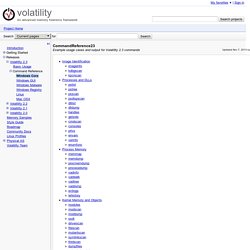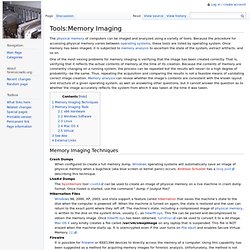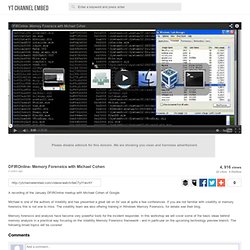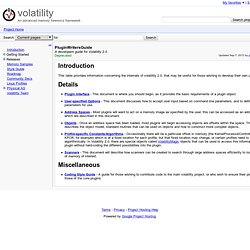

CommandReference23 - volatility - Example usage cases and output for Volatility 2.3 commands - An advanced memory forensics framework. Imageinfo For a high level summary of the memory sample you're analyzing, use the imageinfo command.

Most often this command is used to identify the operating system, service pack, and hardware architecture (32 or 64 bit), but it also contains other useful information such as the DTB address and time the sample was collected. $ python vol.py -f ~/Desktop/win7_trial_64bit.raw imageinfoVolatile Systems Volatility Framework 2.1_alphaDetermining profile based on KDBG search... Suggested Profile(s) : Win7SP0x64, Win7SP1x64, Win2008R2SP0x64, Win2008R2SP1x64 AS Layer1 : AMD64PagedMemory (Kernel AS) AS Layer2 : FileAddressSpace (/Users/Michael/Desktop/win7_trial_64bit.raw) PAE type : PAE DTB : 0x187000L KDBG : 0xf80002803070 Number of Processors : 1 Image Type (Service Pack) : 0 KPCR for CPU 0 : 0xfffff80002804d00L KUSER_SHARED_DATA : 0xfffff78000000000L Image date and time : 2012-02-22 11:29:02 UTC+0000 Image local date and time : 2012-02-22 03:29:02 -0800.
Volatility Technology preview tutorial. This section is a quick tour of the new Volatility TP user interface.

The program can still accept command line options - which we can learn more about by using the --help option: Some of the most frequently used flags are described below: --pager The pager can be specified as the program that will be used to inspect the result of each plugin. Since many plugins produce a great deal of output text, a pager is often needed. --profile The --profile flag specifies the profile to use. --filename The --filename option is the name of the image to analyse. --renderer The --renderer option allows the user to specify the output format for the plugin. --plugin The --plugin option allows the user to specify one or more python modules or zip files which contain third party volatility extension plugins. The interactive shell. Tools:Memory Imaging - ForensicsWiki. The physical memory of computers can be imaged and analyzed using a variety of tools.

Because the procedure for accessing physical memory varies between operating systems, these tools are listed by operating system. Once memory has been imaged, it is subjected to memory analysis to ascertain the state of the system, extract artifacts, and so on. Tools for Memory Forensics. DFIROnline- Memory Forensics with Michael Cohen - YT Channel Embed.
A recording of the January DFIROnline meetup with Michael Cohen of Google Michael is one of the authors of Volatility and has presented a great lab on its' use at quite a few conferences.

If you are not familiar with volatility or memory forensics this is not one to miss. Schuster-Memory_analysis-Prerequisites.pdf. YARA - The pattern matching swiss knife for malware researchers. YARA in a nutshell YARA is a tool aimed at (but not limited to) helping malware researchers to identify and classify malware samples.

With YARA you can create descriptions of malware families (or whatever you want to describe) based on textual or binary patterns. Each description, a.k.a rule, consists of a set of strings and a boolean expression which determine its logic. Let's see an example: The above rule is telling YARA that any file containing one of the three strings must be reported as silent_banker. YARA is multi-platform, running on Windows, Linux and Mac OS X, and can be used through its command-line interface or from your own Python scripts with the yara-python extension.
If you plan to use YARA to scan compressed files (.zip, .tar, etc) you should take a look at yextend, a very helpful extension to YARA developed and open-sourced by Bayshore Networks. Who's using YARA Are you using it? Volatility/example.py at master · volatilityfoundation/volatility · GitHub. PluginWritersGuide - volatility - A developers guide for Volatility 2.0. - An advanced memory forensics framework. This table provides information concerning the internals of volatility 2.0, that may be useful for those wishing to develop their own plugins.

Plugin Interface - This document is where you should begin, as it provides the basic requirements of a plugin object. User-specified Options - This document discusses how to accept user input based on command line parameters, and to define new parameters for use. Address Spaces - Most plugins will want to act on a memory image as specified by the user, this can be accessed as an address space, which are described in this document. Objects - Once an address space has been loaded, most plugins will begin accessing objects are offsets within the space. This document describes the object model, standard routines that can be used on objects and how to construct more complex objects. Memory analysis - ForensicsWiki. Memory Analysis is the science of using a memory image to determine information about running programs, the operating system, and the overall state of a computer.

Because the analysis is highly dependent on the operating system, it has been divided into the following pages: Data types Note that some memory analysis resources and tools are known to completely disregard this aspect of 64-bit computing and claim incorrectly an integer is always 32-bit on 64-bit systems or claim the size of the integer is operating system dependent. When reading primitive data types from a byte stream the endianness specifies how the least and most significant parts of the data are stored [3]. Composite data types (also referred to as data structures) consists of primitive and/or composite data types. When reading data structures from memory note that data structure alignment [4] can be applied. Character and string data types OS-Independent Analysis Encryption Keys See Also External Links. Volatility Labs. Chapter 12. Guest Installation.
In the previous section (see Section 12.1, “Basic Installation with qemu-kvm”, we used the qemu-img command to create an image of a hard disk.

You can, however, use qemu-img for general disk image manipulation. This section introduces useful qemu-img subcommands to help manage the disk images flexibly. 12.2.1. General Information on qemu-img Invocation¶ qemu-img uses subcommands (like zypper does) to do specific tasks. Qemu-img subcommand [options] and supports the following subcommands: create Creates a new disk image on the filesystem. check Checks an existing disk image for errors. convert Converts an existing disk image to a new one in a different format. info.
The Volatility Foundation - Open Source Memory Forensics. Memory Forensics « White Hat School of Technologies. This is an introductory article on Memory Forensics which covers the basic information on what exactly Memory Forensics is and how and why is it useful in any digital forensics investigation.

We also discuss the basic process of conducting Memory Forensics and also the tools required for carrying out that process.